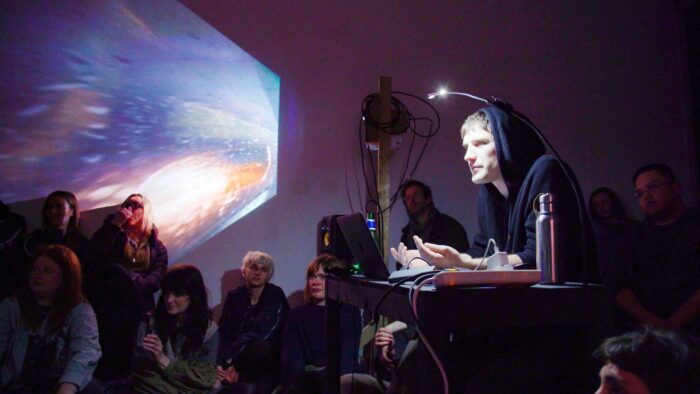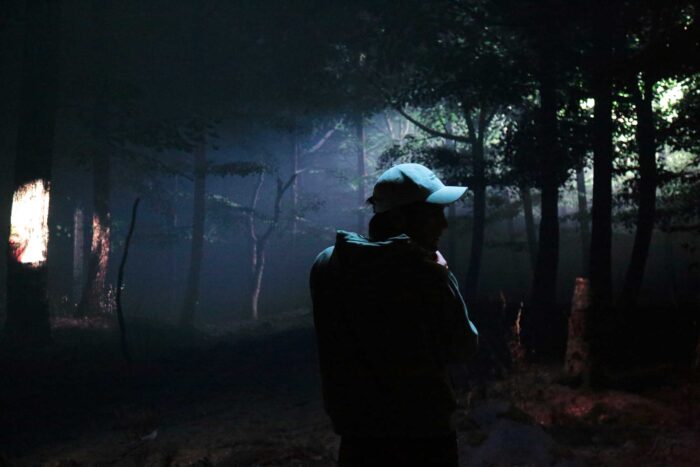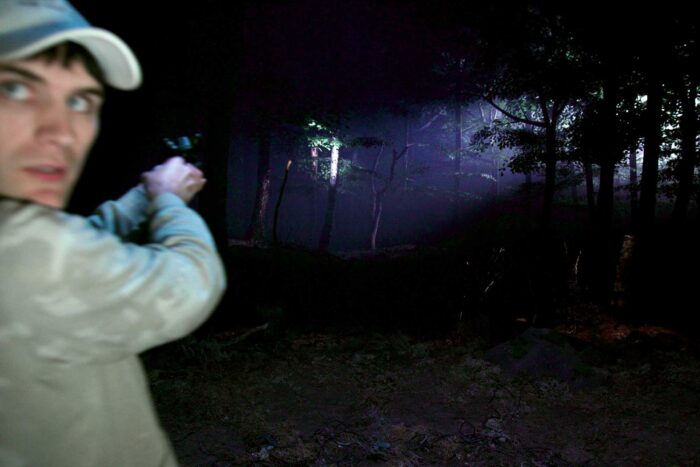A True Story II
Philip Speakman: Katabasing
Another late night at my laptop. This surely can’t become a habit. The piece I have recently been assigned about British artist Philip Speakman is absorbing me much more than I expected. This must be at least the fourth night I end up getting lost in a vortex of open tabs. Wait, did I open this YouTube video? Let’s have a look. It’s becoming difficult to trace a timeline, evidence no longer feels reliable as stories crawl into one another. Speakman’s artworks get blurrier the more I look into them. I am not even scratching the top of the mountain, I feel like it’s the top of the mountain scratching my chin…

I haven’t met Speakman in person, but his name comes up often in London’s art circles —regarded with reverence as someone who understands how stories slip from the imaginary into the real, especially through the very media designed to host them. He seems like a good fit for EchoSignal Journal’s media hauntology agenda I started writing for. The column launched in response to the growing popularity of the New Weird in internet folklore, and the creeping collective realisation that what happens online leaves visible marks on reality. You don’t have to be particularly deep in the discourse to sense it. Sure, “The Dark Forest” might be a term best left to internet theorists or online culturists, but strip away the jargon and the core remains: tech doesn’t just affect the world—it generates new anomalies within it.

Something I have noticed about Speakman’s practice is its spontaneity. His artworks appear almost casual, yet they are haunting. Probably because of their ordinary relatability. Take his moving-image pieces, for instance, which fall somewhere between a Netflix true-crime documentary series, Picnic at Hanging Rock or a personal archive, always anchored in stories that feel deceptively simple. Everyday content delivered candidly, until a strange detail twists reality. Funnily enough, Speakman caught the attention of EchoSignal due to a disturbing synchronicity between one of his projects and a real-world event. A London-based content creator has recently used the backstory of Orphic Chase, a fictional YouTuber from one of Speakman’s works, to orchestrate his disappearance after making a series of politically controversial statements, effectively vanishing from the internet. The project in question is a live performance that Speakman presented in 2024 at Gossamer Fog in London, set within a digitally rendered forest on a large LED wall. The piece begins with Speakman interviewing a writer whose essay on the online trend of Katabasing—also the title of the performance— gains traction after the disappearance of a YouTuber, Orphic Chase precisely, known to have captured strange phenomena with his phone. Following the myth of “katabasis” (the descent into the underworld in Greek mythology) the performance then sees Speakman quoting a digital spell before using a motion-tracked torch to interact with the digital forest, gradually revealing flickering depths of moving matter. Where have I heard this spell before? During the performance, Speakman repeatedly turns back toward the filming camera—and the audience, presumably—as if to remind both himself and the viewer of the reality waiting on the other side of that uncanny forest.

As a passionate follower of the ecogothic genre, I like the recurrence of the forest at night throughout Speakman’s work. What I especially appreciate is the artist’s ability to evoke that distinctive sense of gothic bewilderment, avoiding atmospheric excess in favour of an incorporation of the structural logic of the forest itself: disorienting and free of rational resolution. Elisabeth Parker can be of help here. In her book Forest and Ecogothic, she argues that the gothic forests are sites of epistemological instability, charged with deep cultural and psychological resonance. Across epochs, they have functioned as spaces where linearity fails, and the self becomes porous to its surroundings. I thus see Speakman’s forest-at-night as a way to conjure narrative disorientation, operating as an agent that breaches boundaries and pulls into altered states, where meaning is produced through misdirection, entanglement, and echo. A bit like it is for the internet, defined as “The Dark Forest.” Oh! Another film has just opened automatically on the Vimeo I left running. There is also an earlier video by Speakman where the forest is part of the narrative structure: Chapel Perilous, shot in 2023 as vertical phone footage, which shows a lone dazed narrator, seemingly trapped in a liminal landscape, recounting how they got there. Here, the nature of social media’s performative storytelling collides with the irresistible drive to turn experience into story, and story into shareable myth. This leads to a pivotal aspect in Speakman’s practice: the relationship between online myth-making and misinformation. After all, it’s evident that the artist draws from LARPing, esoteric online subcultures, and conspiracy theories. One of his most recent works, The Road That Eats Thoughts (2025), is a live role-play performance in which four participants enact a group of friends driving at night on their way back from a failed village ritual in 1998. Somewhere along the way linearity begins to unravel, the road too much of the same at each turn. Lynchian in its unfolding, the piece toys with the idea that not only is technology at the basis of collective experience, but that it also seeks to gain something from that. As the game continues, the four participants become increasingly suspicious of the sources of the information made available to them (a distorted radio, and the artist himself acting like a dungeon master or an AI moron assistant pretending to help). They are asked to make choices, but the narrative is built to betray them into AI hallucinations and strange loops. They increasingly find themselves making decisions they thought they’d already made—or recalling outcomes that didn’t happen yet. A sort of story that learns how to spread. A performance about feedback loops, and systems designed to reflect one’s preferences while subtly redirecting them. The narrative is orchestrated to twist back and continue without anyone’s permission, despite the role-play character of the experience, well mirroring the participatory agency that infects and informs the mainstream and that so much interests the artist.

Going back to Orphic Chase though, here is a fun fact: in an article for Contemporary Legend released shortly after the performance, Speakman has introduced the idea of “anomalous tales”, defined by how they affect and infect the real. This seems to be terrifyingly true for the story of Orphic Chase, which has leaked out into the real world and has been used by somebody to truly disappear… oh blimey, have I written this already somewhere else? And what about that note on Orphic Chase I found in Parker’s book? It was my handwriting of course. Judging from the pile of cigarettes accumulating in my ashtray, I must have been in my studio for a long while. I wonder if EchoSignal even exists, if Speakman’s piece is just an excuse. Is this the reason why I am not going out these days? What if I knew who used the Katabasing in the real world? These organism-tales! They live off you until they find another host. I can feel it under my skin.
In his recent essay It May Start Out as a Game But It Ends up a Whole World, British artist, storyteller and PhD scholar Philip Speakman outlines an analysis of what he introduces as “contemporary anomalous tales”, characterised by an infectious allure which troubles the boundaries of both reality and belief. In the essay, the artist draws a comparison between QAnon and creepypasta, investigating how fringe narratives exploit the mechanics of digital platforms to become participatory, viral, and at times dangerously real. These considerations form the backbone of Speakman’s wider artistic output—a practice that explores the agency of the stories we tell and how we are told through them. Working across moving image, live role-play, XR, and workshop formats, he investigates the technology behind contemporary folklore, combining the tropes of the supernatural with staged naturalism to let the narrative take root.
The story you have read imagines a reporter getting tangled in her research into Speakman’s artworks. Needless to say, this text simply mirrors some of the artist’s core considerations. As his website emblematically states, fiction haunts reality like fog precedes a cold morning.
Philip Speakman: Katabasing (A True Story) is part of a trilogy on disappearance inspired by real events.



